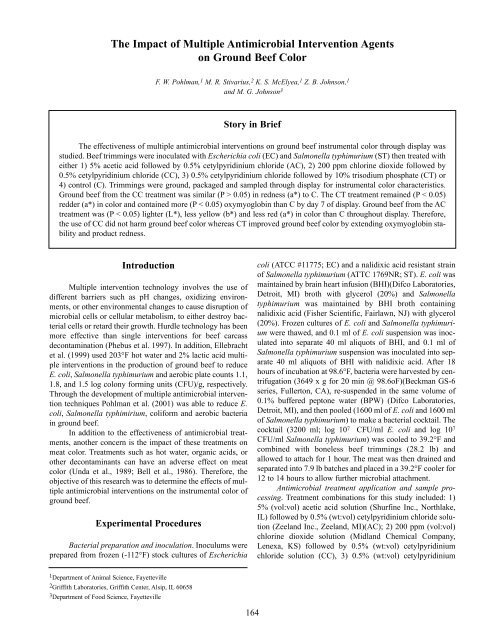Arkansas - Agricultural Communication Services - University of ...
Arkansas - Agricultural Communication Services - University of ...
Arkansas - Agricultural Communication Services - University of ...
You also want an ePaper? Increase the reach of your titles
YUMPU automatically turns print PDFs into web optimized ePapers that Google loves.
The Impact <strong>of</strong> Multiple Antimicrobial Intervention Agents<br />
on Ground Beef Color<br />
F. W. Pohlman, 1 M. R. Stivarius, 2 K. S. McElyea, 1 Z. B. Johnson, 1<br />
and M. G. Johnson 3<br />
Story in Brief<br />
The effectiveness <strong>of</strong> multiple antimicrobial interventions on ground beef instrumental color through display was<br />
studied. Beef trimmings were inoculated with Escherichia coli (EC) and Salmonella typhimurium (ST) then treated with<br />
either 1) 5% acetic acid followed by 0.5% cetylpyridinium chloride (AC), 2) 200 ppm chlorine dioxide followed by<br />
0.5% cetylpyridinium chloride (CC), 3) 0.5% cetylpyridinium chloride followed by 10% trisodium phosphate (CT) or<br />
4) control (C). Trimmings were ground, packaged and sampled through display for instrumental color characteristics.<br />
Ground beef from the CC treatment was similar (P > 0.05) in redness (a*) to C. The CT treatment remained (P < 0.05)<br />
redder (a*) in color and contained more (P < 0.05) oxymyoglobin than C by day 7 <strong>of</strong> display. Ground beef from the AC<br />
treatment was (P < 0.05) lighter (L*), less yellow (b*) and less red (a*) in color than C throughout display. Therefore,<br />
the use <strong>of</strong> CC did not harm ground beef color whereas CT improved ground beef color by extending oxymyoglobin stability<br />
and product redness.<br />
Introduction<br />
Multiple intervention technology involves the use <strong>of</strong><br />
different barriers such as pH changes, oxidizing environments,<br />
or other environmental changes to cause disruption <strong>of</strong><br />
microbial cells or cellular metabolism, to either destroy bacterial<br />
cells or retard their growth. Hurdle technology has been<br />
more effective than single interventions for beef carcass<br />
decontamination (Phebus et al. 1997). In addition, Ellebracht<br />
et al. (1999) used 203°F hot water and 2% lactic acid multiple<br />
interventions in the production <strong>of</strong> ground beef to reduce<br />
E. coli, Salmonella typhimurium and aerobic plate counts 1.1,<br />
1.8, and 1.5 log colony forming units (CFU)/g, respectively.<br />
Through the development <strong>of</strong> multiple antimicrobial intervention<br />
techniques Pohlman et al. (2001) was able to reduce E.<br />
coli, Salmonella typhimirium, coliform and aerobic bacteria<br />
in ground beef.<br />
In addition to the effectiveness <strong>of</strong> antimicrobial treatments,<br />
another concern is the impact <strong>of</strong> these treatments on<br />
meat color. Treatments such as hot water, organic acids, or<br />
other decontaminants can have an adverse effect on meat<br />
color (Unda et al., 1989; Bell et al., 1986). Therefore, the<br />
objective <strong>of</strong> this research was to determine the effects <strong>of</strong> multiple<br />
antimicrobial interventions on the instrumental color <strong>of</strong><br />
ground beef.<br />
Experimental Procedures<br />
Bacterial preparation and inoculation. Inoculums were<br />
prepared from frozen (-112°F) stock cultures <strong>of</strong> Escherichia<br />
coli (ATCC #11775; EC) and a nalidixic acid resistant strain<br />
<strong>of</strong> Salmonella typhimurium (ATTC 1769NR; ST). E. coli was<br />
maintained by brain heart infusion (BHI)(Difco Laboratories,<br />
Detroit, MI) broth with glycerol (20%) and Salmonella<br />
typhimurium was maintained by BHI broth containing<br />
nalidixic acid (Fisher Scientific, Fairlawn, NJ) with glycerol<br />
(20%). Frozen cultures <strong>of</strong> E. coli and Salmonella typhimurium<br />
were thawed, and 0.1 ml <strong>of</strong> E. coli suspension was inoculated<br />
into separate 40 ml aliquots <strong>of</strong> BHI, and 0.1 ml <strong>of</strong><br />
Salmonella typhimurium suspension was inoculated into separate<br />
40 ml aliquots <strong>of</strong> BHI with nalidixic acid. After 18<br />
hours <strong>of</strong> incubation at 98.6°F, bacteria were harvested by centrifugation<br />
(3649 x g for 20 min @ 98.6oF)(Beckman GS-6<br />
series, Fullerton, CA), re-suspended in the same volume <strong>of</strong><br />
0.1% buffered peptone water (BPW) (Difco Laboratories,<br />
Detroit, MI), and then pooled (1600 ml <strong>of</strong> E. coli and 1600 ml<br />
<strong>of</strong> Salmonella typhimurium) to make a bacterial cocktail. The<br />
cocktail (3200 ml; log 10 7 CFU/ml E. coli and log 10 7<br />
CFU/ml Salmonella typhimurium) was cooled to 39.2°F and<br />
combined with boneless beef trimmings (28.2 lb) and<br />
allowed to attach for 1 hour. The meat was then drained and<br />
separated into 7.9 lb batches and placed in a 39.2°F cooler for<br />
12 to 14 hours to allow further microbial attachment.<br />
Antimicrobial treatment application and sample processing.<br />
Treatment combinations for this study included: 1)<br />
5% (vol:vol) acetic acid solution (Shurfine Inc., Northlake,<br />
IL) followed by 0.5% (wt:vol) cetylpyridinium chloride solution<br />
(Zeeland Inc., Zeeland, MI)(AC); 2) 200 ppm (vol:vol)<br />
chlorine dioxide solution (Midland Chemical Company,<br />
Lenexa, KS) followed by 0.5% (wt:vol) cetylpyridinium<br />
chloride solution (CC), 3) 0.5% (wt:vol) cetylpyridinium<br />
1 Department <strong>of</strong> Animal Science, Fayetteville<br />
2 Griffith Laboratories, Griffith Center, Alsip, IL 60658<br />
3 Department <strong>of</strong> Food Science, Fayetteville<br />
164

















